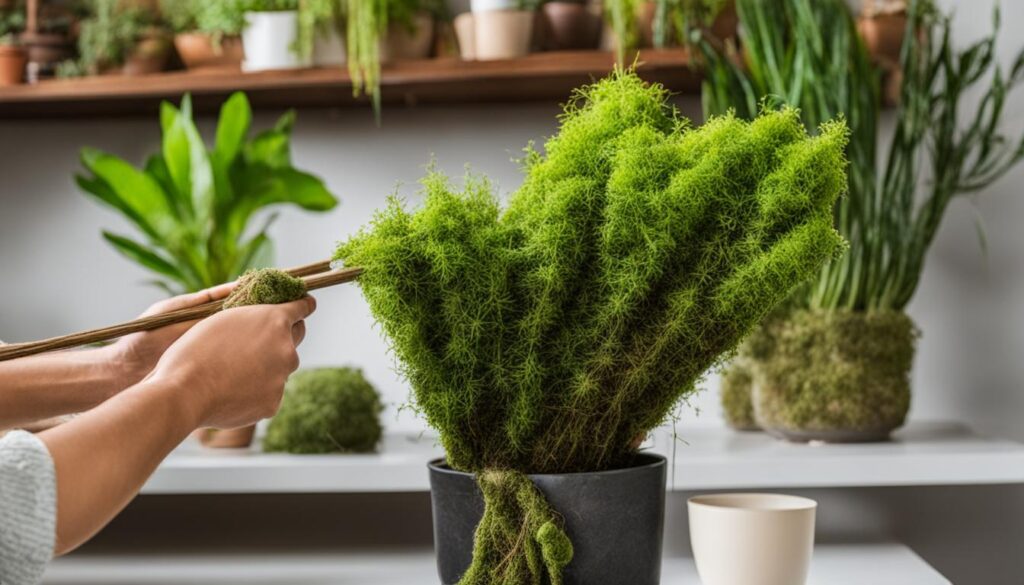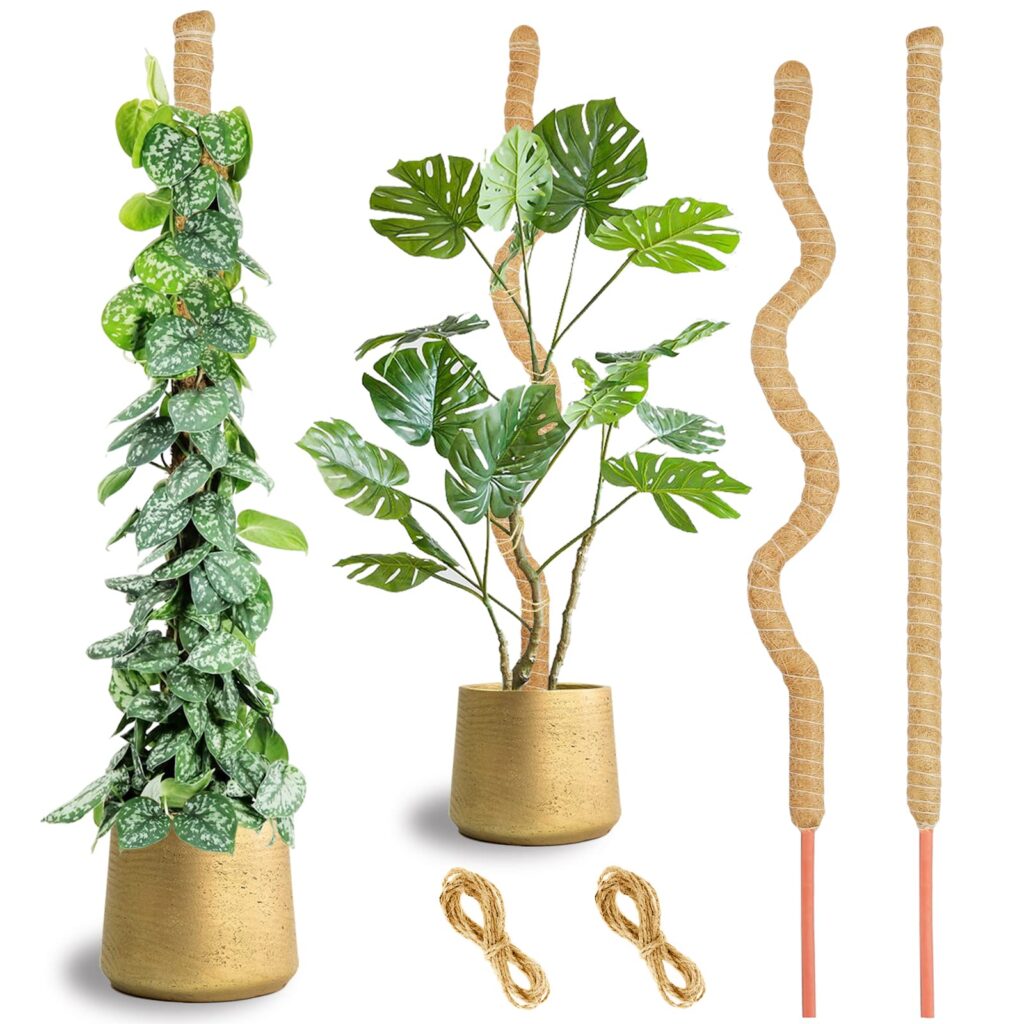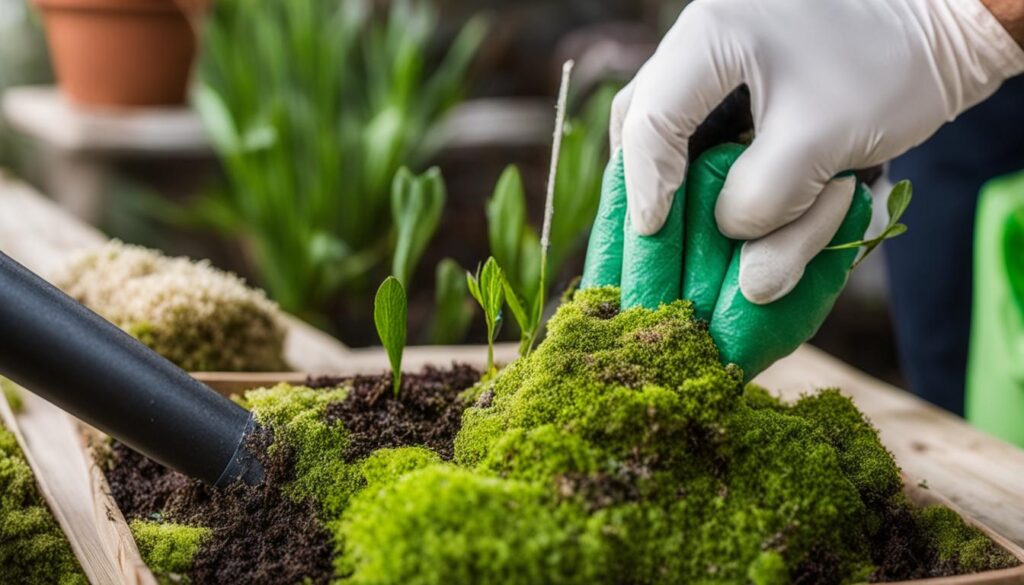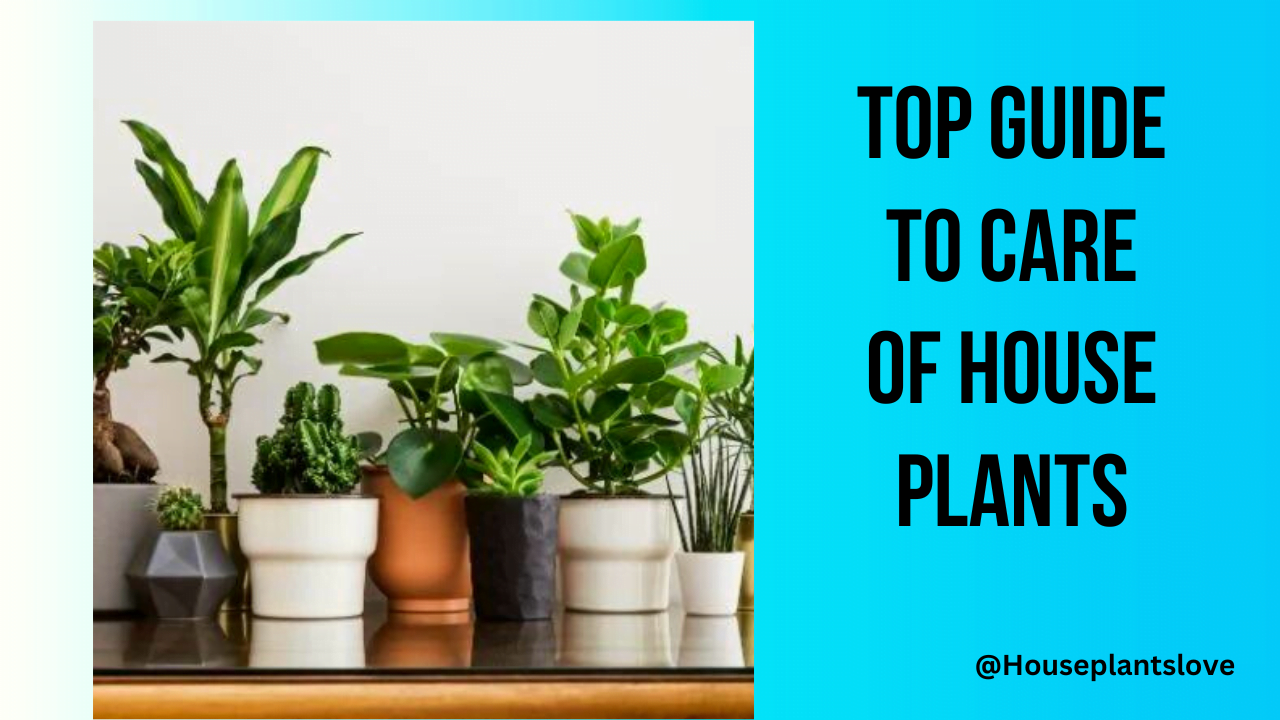How to Use, and Create a Moss Pole for Indoor Plants: Benefits Explained
Are you looking to enhance your indoor plant collection? Do you want to support your climbing plants and promote upward growth? Look no further – moss poles are the solution you’ve been searching for! In this article, I will guide you through the process of using and creating moss poles for your indoor plants.
But first, let’s discuss the benefits of using moss poles for your houseplants. When you use a moss pole, you gain increased flexibility in plant placement, allowing you to strategically position your plants for optimal growth. Additionally, moss poles help conserve space, making them perfect for smaller areas.
Not only do moss poles offer practical advantages, but they also contribute to the aesthetic appeal of your indoor garden. By providing a structured support system, moss poles create a visually pleasing look for your climbing or hanging plants. You can transform your indoor space into a natural and vibrant oasis.
Now that you understand the benefits of moss poles, let’s delve into the details. I will explain what materials are used to make moss poles, which plants benefit from their use, and how to effectively incorporate moss poles into your plant care routine.

Continue reading to discover the wonders of moss poles and how they can elevate your indoor plant game!
Why Should Use a Moss Pole for Houseplants?
If you’re looking to enhance the growth and appearance of your indoor plants, using a moss pole is a fantastic solution. Moss poles offer numerous benefits that can help your houseplants thrive and create a visually appealing display.
One of the advantages of using a moss pole is the ability to shape your plant and direct its growth. By providing a structure for your climbing or hanging plants to attach to, you have more control over their growth direction, allowing you to create stunning visual displays or manage plant placement in your space.
Another benefit of using a moss pole is the space efficiency it provides. By training your plants to grow vertically with a moss pole, you can save valuable floor space and accommodate more plants in a smaller area. This is particularly useful for those with limited space or those looking to create a lush indoor jungle.
Furthermore, a moss pole gives your plants a more structured and aesthetically pleasing look. The natural materials used to make moss poles, such as dried moss, coconut fiber, and bamboo, add a touch of beauty and authenticity to your indoor garden. With a moss pole, you can create a more natural and healthy environment for your climbing or hanging plants, allowing them to thrive and flourish.
What is a Moss Pole Made Of?
Moss poles are typically made from a combination of natural materials such as dried moss, coconut fiber, and bamboo. These materials provide a supportive structure for plants to attach their tendrils or aerial roots. The inner pole of the moss pole can be made of wood or plastic, with plastic being the preferred option to prevent rotting. It is important to select the right type of moss pole material based on the needs of your specific plant. Some plants may require more support than others, so choose a moss pole that suits your plant’s requirements.

When it comes to the outer covering of the moss pole, dried moss is commonly used. This natural material helps to create a humid environment that mimics the plant’s natural habitat, encouraging healthy growth. Coconut fiber is another popular option for the outer layer, as it is durable and provides a rough texture for plants to attach to.
To summarize, a moss pole is typically made of a combination of dried moss, coconut fiber, and bamboo. The inner pole can be made of plastic or wood, and the outer covering is often made of dried moss or coconut fiber. By choosing the right materials, you can provide the necessary support and environment for your climbing or hanging plants.
Bamboo and Coconut Fiber Comparison
| Material | Advantages | Disadvantages |
|---|---|---|
| Bamboo | – Sturdy and durable – Environmentally friendly – Natural appearance | – May rot if not properly sealed – Limited flexibility – Can be more expensive |
| Coconut Fiber | – Lightweight – Provides a rough texture for plants to attach to – Affordable | – May deteriorate over time – Less visually appealing |
Which Plants Benefit from a Moss Pole?
Moss poles are particularly beneficial for climbing plants and hanging plants. These types of plants naturally grow vertically in their natural habitats, attaching themselves to trees or other solid structures. By providing a moss pole for your climbing or hanging plants, you are mimicking their natural environment and supporting their growth. Plants such as Monstera, Philodendron, Golden Pothos, and other climbing or trailing species can greatly benefit from a moss pole.
What are the Benefits of using moss poles for climbing plants:
- Promotes upward growth: Moss poles provide a vertical support system for climbing plants, allowing them to grow toward the light and reach their full potential.
- Creates a stable structure: The moss pole gives the climbing plant something to attach to, preventing it from sprawling or falling over.
- Enhances aesthetics: The moss pole adds visual interest to the plant display, creating a more natural and appealing look.
- Increases air circulation: By training the plant to grow vertically, a moss pole allows for better airflow around the leaves, reducing the risk of moisture-related diseases.
What are the Benefits of using moss poles for hanging plants:
- Promotes healthy growth: Hanging plants can benefit from a moss pole by providing them with a structure to grow on, encouraging upward growth, and preventing tangled or drooping vines.
- Improves plant shape: Moss poles help hanging plants maintain a more compact and aesthetically pleasing shape, preventing them from becoming straggly or unbalanced.
- Creates a focal point: The moss pole adds visual interest and creates a focal point in your indoor garden or living space.
- Allows for higher placement: Hanging plants with a moss pole can be placed at a higher level, maximizing vertical space and adding visual depth to your indoor garden.
Overall, moss poles provide essential support and structure for climbing and hanging plants, allowing them to thrive and create a visually stunning display. Whether you have a Monstera reaching for the sky or a trailing Pothos cascading down, a moss pole can be a valuable addition to your houseplant collection.
How to Use a Moss Pole?
Using a moss pole is a simple and effective way to support your climbing or hanging plants and encourage upward growth. Here are the steps to make a moss pole for your houseplants:
- Select a suitable size and type of moss pole for your plant. Consider the height and width of the plant, the weight and length of the vines or stems, and the level of support needed.
- If necessary, repot your plant together with the moss pole. Ensure that the roots are placed around the pole and secure the pole in the pot with enough soil for stability.
- Gently guide the stems or vines of the plant towards the moss pole. You can use Velcro strips, gardening tubes, or other soft ties to attach them.
- As the plant grows, continue to guide it along the moss pole, providing support and encouraging upward growth.
By following these steps, you can effectively use a moss pole to support and shape the growth of your climbing or hanging plants.
Important Tips for How to Creating a Moss Pole
Here are some additional tips to keep in mind when creating a moss pole for your houseplants:
- Choose a moss pole material that suits your plant’s requirements. Some plants may require more support than others, so select a material that provides the necessary structure.
- Regularly check the moisture level of the moss pole and water it if necessary. Keeping the moss pole moist will provide a suitable environment for the plant to attach and grow.
- Mist the pole occasionally to increase humidity around the plant.
- If the moss on the pole starts to dry out or degrade, replace it with fresh moss or coconut fiber.
| Benefits | Advantages of Using Moss Poles |
|---|---|
| 1. Enhanced Plant Growth | Moss poles promote upward growth and provide support for climbing or hanging plants, resulting in healthier and stronger growth. |
| 2. Improved Plant Aesthetics | Moss poles give your plants a structured and visually appealing look, enhancing the beauty of your indoor garden. |
| 3. Space Efficiency | Using moss poles allows for more plants in a smaller area, making efficient use of space. |
| 4. Flexibility in Placement | Moss poles provide flexibility in plant placement, allowing you to shape your plant and control its growth direction. |
By following these tips and utilizing the benefits of moss poles, you can create a thriving and visually appealing indoor plant display.
Tips and Tricks for Using a Moss Pole
Proper care and maintenance of your moss pole are essential for the successful growth of your indoor plants. Here are some tips and tricks to ensure your moss pole remains in excellent condition:
- Check the moisture level of the moss pole regularly. If it feels dry, water it to keep it moist. This will provide a suitable environment for the plant to attach and grow.
- Mist the moss pole occasionally to increase humidity around the plant. This will help create a favorable growing environment.
- If you notice the moss on the pole starting to dry out or degrade, replace it with fresh moss or coconut fiber. This will ensure that the plant has a stable surface to attach to.
- Monitor the growth of your plant and adjust the ties or attachments as needed to provide proper support. As the plant grows, it may require additional guidance along the moss pole.
- Regularly inspect the moss pole for any signs of damage or instability. Take appropriate measures to maintain its integrity, such as reinforcing the pole or replacing it if necessary.
By following these simple tips, you can ensure that your moss pole provides the necessary support and care for your indoor plants, promoting healthy and strong growth.
Alternatives to Moss Poles
If you’re looking for alternatives to moss poles for supporting your climbing and hanging plants, there are several options to consider. These alternatives can provide the necessary support while offering different aesthetics and functionality. Here are some popular alternatives:
Trellises
Trellises are vertical structures consisting of a framework of intersecting bars or lattices. They can be made of materials such as bamboo, metal, or wood, and are available in various sizes and designs. Trellises provide a sturdy support system for climbing plants, allowing them to grow vertically while adding a decorative element to your indoor garden.
Stakes
Stakes are long, slender rods that can be inserted into the soil next to your plants. They are commonly made of materials like bamboo or metal. Stakes provide a simple and effective solution for supporting tall or top-heavy plants. By attaching the vines or stems to the stakes, you can help guide the growth of the plant in the desired direction.
Wall-Mounted Supports
If you have limited space or prefer a more discreet option, wall-mounted supports may be a suitable alternative. These supports can be attached to walls or other vertical surfaces, providing a stable structure for your climbing or hanging plants. Wall-mounted supports come in various designs and materials, including metal brackets, hooks, or hangers, allowing you to customize the look and functionality according to your needs.
| Alternative | Description |
|---|---|
| Trellises | Vertical structures with intersecting bars or lattices |
| Stakes | Long rods inserted into the soil for support |
| Wall-Mounted Supports | Suitable for limited space, attached to walls or vertical surfaces |
When choosing an alternative to a moss pole, consider the specific needs of your plants, the available space, and your personal preferences. Each option offers its own advantages, so select the one that best suits your indoor gardening goals and complements the overall design of your space.
Reusing and Extending Moss Poles
Reusing moss poles is a practical and sustainable way to extend the life of these versatile plant supports. When it’s time to replace the plant attached to the moss pole, simply remove any old plant material and clean the pole before attaching a new plant. By reusing moss poles, you can maximize their use and reduce waste.
If your plant outgrows the height of the moss pole, don’t worry – you can easily extend it. Start by cutting off the top of the existing pole, ensuring a clean and straight cut. Then, insert a new moss pole of the desired height into the existing pole. Secure them together for stability, such as using gardening tape or wire. This method allows you to adapt the height of the moss pole to accommodate the growing needs of your plant.
By reusing and extending moss poles, you can save money, reduce environmental impact, and continue providing the necessary support for your climbing or hanging plants. It’s a simple yet effective solution for maintaining healthy and thriving greenery in your indoor garden.

Pros and Cons of Reusing and Extending Moss Poles
| Pros | Cons |
|---|---|
| Maximizes the use of moss poles | Requires cleaning and maintenance |
| Reduces waste and environmental impact | May require additional materials for extension |
| Cost-effective | Not suitable for all plant species |
| Allows for flexibility in adjusting the height of the moss pole | Can be challenging to securely attach the extension |
Benefits of Using Moss Poles for Houseplants
Using moss poles for your houseplants offers a range of benefits that can enhance both the aesthetic appeal and the overall health of your indoor garden. Here are the advantages of incorporating moss poles into your plant care routine:
Improved Plant Growth and Support
Moss poles provide the necessary structure and support for climbing or hanging plants to grow vertically. This promotes healthier and stronger growth by allowing the plants to mimic their natural environment. As the plant attaches itself to the moss pole, it can grow upwards, producing longer stems, and creating a lush, full appearance. The support offered by the moss pole also helps prevent the plant from sprawling or drooping, keeping it neatly contained and visually pleasing.
Enhanced Air Circulation and Plant Health
By using a moss pole, you create a more open and airy environment for your houseplants. The vertical growth encouraged by the pole allows for better air circulation around the plant, reducing the risk of moisture-related diseases and pests. Improved air circulation also helps prevent the growth of mold or mildew on the plant’s leaves. Additionally, the stability provided by the moss pole allows the plant to focus its energy on growth and development, leading to healthier and more robust foliage.
Increase in Visual Appeal
Moss poles add a touch of natural beauty and elegance to your indoor garden. The organic materials used in the construction of moss poles, such as dried moss, coconut fiber, and bamboo, blend seamlessly with the plant’s surroundings, creating a visually cohesive display. The vertical growth and support offered by the moss pole create a more structured and well-defined look for your climbing or hanging plants, making them stand out as focal points in your space. The lush foliage cascading from the moss pole creates a sense of lushness and vibrancy, transforming your indoor garden into a visually captivating oasis.
Using moss poles for your houseplants provides numerous advantages, including improved plant growth and support, enhanced air circulation, and an increase in visual appeal. Incorporating moss poles into your indoor garden can help create a healthier and more aesthetically pleasing environment for your plants to thrive. Experiment with different moss pole styles and materials to find the perfect fit for your houseplants, and enjoy the benefits of their vertical growth and beauty.
Choosing the Right Moss Pole for Your Plant
When it comes to selecting a moss pole for your houseplants, it’s important to consider the specific needs and characteristics of your plant. Different plants have different growth habits, sizes, and support requirements, so choosing the right moss pole is essential for their well-being. Here are some factors to keep in mind:
Plant Size and Growth Habits
Take into account the height and width of your plant, as well as the length and weight of its vines or stems. Some plants may require a taller moss pole to provide adequate support, while others may do well with a smaller one. Consider whether your plant has the tendency to climb or hang, as this will also influence the type of moss pole you choose.
Moss Pole Materials
Moss poles can be made from various materials such as dried moss, coconut fiber, or bamboo. Each material has its own advantages and considerations. Dried moss is a popular choice as it provides a natural and aesthetically pleasing look. Coconut fiber is known for its durability and moisture-retaining properties. Bamboo poles are sturdy and long-lasting. Consider the pros and cons of each material and choose one that suits your plant’s needs.
Support and Durability
Ensure that the moss pole you select provides adequate support for your plant. A strong and stable pole is essential for preventing your plant from toppling over or sagging under its own weight. Consider the thickness and strength of the pole, as well as any additional features such as hooks or attachments for better support. Durability is also important, as you want a moss pole that will last for a long time without deteriorating or rotting.
| Plant | Recommended Moss Pole |
|---|---|
| Monstera | Bamboo moss pole |
| Philodendron | Coconut fiber moss pole |
| Golden Pothos | Dried moss pole |
Note: The table above provides some recommendations for moss poles based on common houseplant varieties. However, it’s important to assess the specific needs of your individual plant before making a final decision.
By considering the size and growth habits of your plant, the materials used in the moss pole, and the level of support and durability needed, you can choose the right moss pole that will provide optimal growth conditions for your houseplants.
Caring for Moss Poles: Essential Maintenance Tips
Proper maintenance of moss poles is crucial for ensuring their longevity and effectiveness in supporting your climbing or hanging plants. By following these essential care tips, you can keep your moss poles in optimal condition and provide the necessary support for your plants’ growth.
Regular Moisture Check
Moss poles thrive in a moist environment, as it encourages plants to attach and grow. Regularly check the moisture level of your moss pole and water or mist it as needed. Keep in mind that each plant has different moisture requirements, so adjust your watering routine accordingly. Maintaining the right level of moisture will provide a conducive environment for your plants.
Replace Deteriorated Moss
Over time, the moss on your pole may start to deteriorate due to natural wear and tear or excessive dryness. If you notice any signs of degradation, it’s important to replace the moss with fresh moss or coconut fiber. This will ensure that your pole continues to provide a stable structure for your plants to grow against.
Monitor Growth and Adjust Support
As your plants grow, it’s essential to monitor their growth and adjust the ties or attachments to provide adequate support. Regularly inspect the moss pole for any signs of damage or instability. By proactively adjusting the support, you can prevent your plants from sagging or leaning and maintain their upward growth.
| Moss Pole Maintenance Checklist | Frequency |
|---|---|
| Check moisture level | Weekly |
| Water or mist moss pole | As needed |
| Replace deteriorated moss | When necessary |
| Monitor plant growth | Regularly |
| Adjust support ties or attachments | As needed |
By following these maintenance tips, you can ensure that your moss poles continue to provide the necessary support for your climbing or hanging plants. With proper care, your indoor garden will thrive, and you’ll enjoy the benefits of healthier and more visually appealing houseplants.

Conclusion
In conclusion, using a moss pole for my indoor plants has been a game-changer. Not only does it provide essential support for climbing and hanging plants, but it also adds a touch of natural beauty to my indoor garden.
One of the greatest benefits I’ve experienced is the ability to shape my plants and control their growth direction. With a moss pole, I have more flexibility in plant placement, allowing me to maximize space and have more plants in a smaller area.
Additionally, the moss pole enhances the aesthetics of my plants, giving them a structured and visually appealing look. It creates a natural environment for my climbing and hanging plants, promoting healthier growth and overall plant health.
By following proper care and maintenance, such as keeping the moss pole moist and replacing deteriorating moss, I can continue to enjoy the benefits of using moss poles for my indoor plants. With these simple techniques, my plants thrive and flourish, creating a vibrant and visually pleasing indoor garden.
FAQ
Why should I use a moss pole for my houseplants?
Using a moss pole provides several benefits, including increased flexibility in plant placement, space efficiency, the ability to shape the plant, and improved aesthetics.
What materials are moss poles made of?
Moss poles are typically made from natural materials such as dried moss, coconut fiber, and bamboo. The inner pole can be made of wood or plastic.
Which plants benefit from a moss pole?
Climbing plants and hanging plants, such as Monstera, Philodendron, and Golden Pothos, can greatly benefit from a moss pole.
How do I use a moss pole?
To use a moss pole, select a suitable size and type for your plant, repot if necessary, secure the pole in the pot, guide the stems or vines towards the pole, and provide support as the plant grows.
How do I care for a moss pole?
Regularly check the moisture level of the moss pole and water or mist it as needed. Replace the moss or coconut fiber if it starts to dry out or degrade. Monitor the growth of your plant and adjust the ties or attachments as necessary.
Are there alternatives to moss poles?
Yes, trellises, stakes, and wall-mounted supports are alternative options for supporting plants to grow vertically.
Can moss poles be reused?
Yes, moss poles can be reused for different plants by removing any old plant material and cleaning the pole before attaching a new plant.
Can I extend a moss pole?
Yes, if your plant outgrows the height of the moss pole, you can extend it by attaching another moss pole to the existing one.
What are the benefits of using moss poles for houseplants?
Moss poles provide support for climbing or hanging plants, promote healthier and stronger growth, create a more natural and aesthetic look, and improve overall plant health.
How do I choose the right moss pole for my plant?
Consider the specific needs and characteristics of your plant, such as its growth habits, size, and support requirements when selecting a moss pole.
How do I maintain and care for a moss pole?
Keep the moss pole moist, replace the moss or coconut fiber if necessary, monitor the growth of your plant, and regularly inspect the moss pole for any signs of damage or instability.




